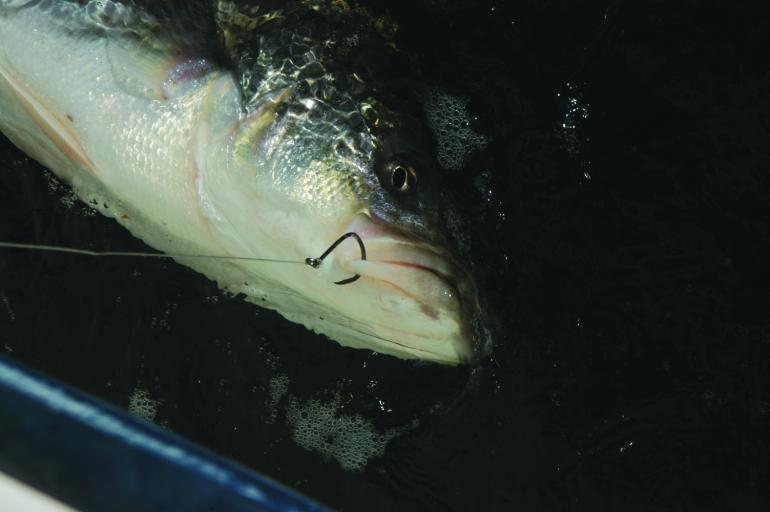You’ve matched the hatch, made another nice cast, and watched in attentive meditation as your fly drifts downstream and begins to pause in the eddy behind the boulder you know well. Imperceptibly, it vanishes. And in the instant it takes for you to strip the line tight, there’s a rainbow in the air.

Somewhere under the rainbow, this question: Does it hurt?
Those of us who love to fish have at some point asked ourselves, “Do fish feel any pain?” If they do, why would they pull so hard against hooks? Wouldn’t that cause them more pain? Sure, a leaping fish is at least bothered. It seems panicked and stressed when struggling against a line. But can it feel pain?
I think so.
Yet if it can, does it? A few years ago I stepped on a fish hook the size of my index finger. You’re probably thinking, “Ouch.” But I didn’t even realize it was stuck in my foot past the barb until I tried to pull it out of my shoe. I hadn’t felt it pierce me.
I didn’t perceive pain at that moment. My body went into physical fight-or-flight mode, dilating my aorta to receive more blood. But I wasn’t leaping or struggling. Just staring in disbelief at my foot; it didn’t raise my heart rate or blood flow. And so my blood pressure dropped, making me feel faint. But still, I felt no pain for quite a while. Could a similar pain-suppressing response occur in a hooked fish, allowing it to pull strongly against a steel point in its mouth without apparent acute discomfort?
I think so.
Humans express their pain to other humans by mainly by vocalizing — saying that they hurt. Some non-human animals also express pain vocally. My dogs yelp if one hurts another during rough wrestling on the beach. Other animals — from pigs to cats to birds to raccoons — scream or squeal — when they feel pain.
It’s akin to hearing a person discuss their pain in a language we’re unfamiliar with. Just because I don’t speak that person’s language doesn’t mean they’re not able to express their pain.
Fish aren’t fluent in human languages, but some vocalize. Those that do, grunt, croak, and drum to communicate with other fish. Others use body language. Do some of these sounds and signs signify pain?
I think so.
Once, I began tossing chunks of fish to a blue shark my crew and I had attracted to our boat with mashed-up fish. The shark was feeding quite actively, grabbing and gobbling down each piece of fish as soon as it plunked into the water. When a stinging species of jellyfish called a lion’s mane drifted out from beneath the boat, the shark bit it, apparently by mistake. The shark immediately began shaking its head back and forth, releasing the jelly from its jaws in apparent pain.
On the other hand stinging jellyfish are a primary food source for sea turtles. I’ve seen plenty of leatherback turtles feed on lion’s mane jellyfish without any apparent discomfort.
Brains create sensations of pain to help animals avoid or withdraw from things that might harm them, like stinging jellyfish. A stingray’s venomous spine is a defense mechanism that causes pain in predators including fish and marine mammals.
Stingrays evolved, along with their pain-inducing defense system, more than 100 million years ago. So did the fish that try to eat stingrays. And so did other species of venomous fish, such as puffers and lionfish. These pain-causing sea creatures evolved many millions of years before humans were around to experience pain.
You don’t think stingrays and other fish developed their painful defense systems just for us, do you?
I don’t think so.
THE COUNTER-ARGUEMENT
by Brian Key
ABSTRACT
Only humans can report feeling pain. In contrast, pain in animals is typically inferred on the basis of nonverbal behaviour. Unfortunately, these behavioural data can be problematic when the reliability and validity of the behavioural tests are questionable.
The thesis proposed here is based on the bioengineering principle that structure determines function. Basic functional homologies can be mapped to structural homologies across a broad spectrum of vertebrate species. For example, olfaction depends on olfactory glomeruli in the olfactory bulbs of the forebrain, visual orientation responses depend on the laminated optic tectum in the midbrain, and locomotion depends on pattern generators in the spinal cord throughout vertebrate phylogeny, from fish to humans. Here I delineate the region of the human brain that is directly responsible for feeling painful stimuli. The principal structural features of this region are identified and then used as biomarkers to infer whether fish are, at least, anatomically capable of feeling pain. Using this strategy, I conclude that fish lack the necessary neurocytoarchitecture, microcircuitry, and structural connectivity for the neural processing required for feeling pain.

Brian Key is Head of the Brain Growth and Regeneration Lab at the University of Queensland, dedicated to understanding the principles of stem cell biology, differentiation, axon guidance, plasticity, regeneration and development of the brain. [email protected]
* * * *












Leave a Comment Here